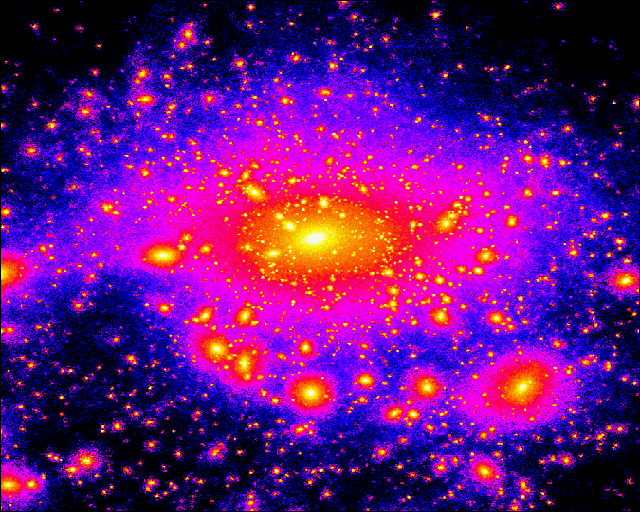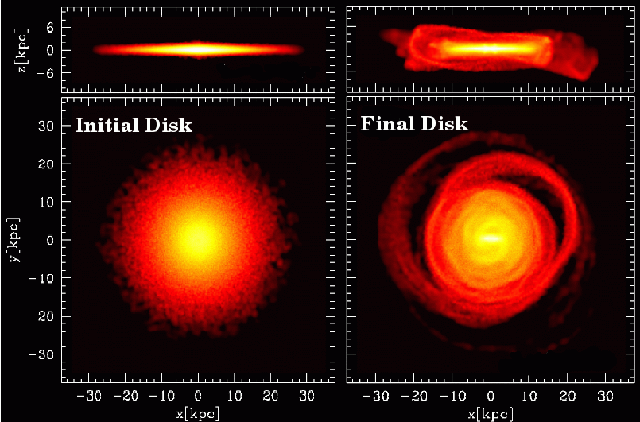As scientists attempt to learn more about how galaxies evolve, they seek to find out whether collisions with our dwarf galactic neighbors will one day tear apart the disk of the Milky Way.
That grisly fate is unlikely, a new study now suggests.
While astronomers know that such collisions probably have occurred in the past, new computer simulations show that instead of destroying a galaxy, these collisions “puff up” a galactic disk, particularly around the edges, and produce structures called stellar rings.
The finding solves two mysteries: the likely fate of the Milky Way at the hands of its satellite galaxies — the most massive of which are the Large and Small Magellanic Clouds — and the origin of its puffy edges, which astronomers have seen elsewhere in the universe and dubbed “flares.”
The mysterious dark matter that makes up most of the universe plays a role, the study found.
Astronomers believe that all galaxies are embedded within massive and extended halos of dark matter and that most large galaxies lie at the intersections of filaments of dark matter, which form a kind of gigantic web in our universe. Smaller satellite galaxies flow along strands of the web and get pulled into orbit around large galaxies such as our Milky Way.
Ohio State University astronomer Stelios Kazantzidis and his colleagues performed detailed computer simulations of galaxy formation to determine what would happen if a satellite galaxy — such as the Large Magellanic Cloud and its associated dark matter — collided with a spiral galaxy such as our own.
Their conclusion: The satellite galaxy would gradually disintegrate while its gravity tugged at the larger galaxy’s edge, drawing out stars and other material. The result would be a flared galactic disk such as that of the Milky Way, which starts out narrow at the center and then widens toward the edges.
The results may ease the mind of anyone who feared that our galactic neighbors and their associated dark matter would eventually destroy our galactic disk — albeit billions of years from now.
Kazantzidis couldn’t offer a 100-percent guarantee, however.
“We can’t know for sure what’s going to happen to the Milky Way, but we can say that our findings apply to a broad class of galaxies similar to our own,” Kazantzidis said. “Our simulations showed that the satellite galaxy impacts don’t destroy spiral galaxies. They actually drive their evolution by producing this flared shape and creating stellar rings — spectacular rings of stars that we’ve seen in many spiral galaxies in the universe.”
He and his colleagues didn’t set out solely to determine the fate of our galaxy. In two papers that have appeared in the Astrophysical Journal, they report that their simulations offer a new way to test — and validate — the current cosmological model of the universe.
This is the first time that collisions between spiral galaxies and satellites have been simulated at this level of detail, Kazantzidis said. The study revealed that galaxies’ flared edges and stellar rings are visible signs of these interactions.
Our galaxy measures 100,000 light-years across (1 light-year equals 6 trillion miles [10 trillion kilometers]). Yet we are surrounded by a cloud or “halo” of dark matter that’s 10 times bigger — 1 million light-years across — he explained.
While astronomers envision the dark matter halo as partly diffuse, it contains dense regions that orbit our galaxy in association with satellite galaxies, such as the Magellanic Clouds.
“We know from cosmological simulations of galaxy formation that these smaller galaxies probably interact with galactic disks very frequently throughout cosmic history. Since we live in a disk galaxy, it is an important question whether these interactions could destroy the disk,” Kazantzidis said. “We saw that galaxies are not destroyed, but the encounters leave behind a wealth of signatures that are consistent with the current cosmological model, and consistent with our observations of galaxies in the universe.”
One signature is the flaring of the galaxy’s edges, just as the edges of the Milky Way and of other external galaxies are flared.
“We consider this flaring to be one of the most important observable consequences of interactions between infalling satellite galaxies and the galactic disk,” Kazantzidis said.
In both articles, the researchers considered the impacts of many different smaller galaxies onto a larger, primary disk galaxy. They calculated the likely number of satellites and the orbital paths of those satellites, and then they simulated what would happen during collision, including when the dark matter interacted gravitationally with the disk of the spiral galaxy.
None of the disk galaxies was torn apart; to the contrary, the primary galaxies gradually disintegrated the infalling satellites, whose material ultimately became part of the larger galaxy.
The satellites passed through the galactic disk over and over. On each pass, they would lose some of their mass, a process that would eventually destroy them completely. Though the primary galaxy survived, it did form flared edges which closely resembled our galaxy’s flared appearance today.
“Every spiral galaxy has a complex formation and evolutionary history,” Kazantzidis said. “We would hope to understand exactly how the Milky Way formed and how it will evolve. We may never succeed in knowing its exact history, but we can try to learn as much as we can about it, and other galaxies like it.”











